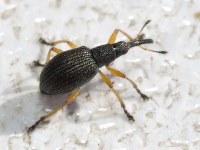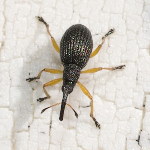Phylum Arthropoda (Arthropods) ➔ Subphylum Hexapoda (Hexapods) ➔ Class Insecta (Insects) ➔ Order Coleoptera (Beetles) ➔ Family Apionidae (Apionid weevils)
Protapion fulvipes (Geoffroy, 1785)
Rotfüßiger Klee-Spitzmausrüssler White Clover Seed Weevil
Synonyms and other combinations:
Rhinomacer fulvipes Geoffroy, 1785 | Curculio flavipes Paykull, 1792 | Apion lederi Kirsch, 1878 | Apion dichroum Bedel, 1886 | Apion apicirostre Desbrochers, 1895 | Apion bergrothi Desbrochers, 1895 | Apion coxale Desbrochers, 1895 | Apion maculicoxis Desbrochers, 1897 |
Classification:
Protapion fulvipes belongs to the subfamily Apioninae.Distribution:
Palearctic, widespread in Europe, common in Central Europe.Habitat:
grasslandDescription:
Size 1.8 - 2.2 mm; body black; elytra highly arched and with pronounced shoulders, long-oval; pronotum densely and strongly punctured, with clear central groove at the back; antennal flagellum yellow at the base, black towards the apex; the antennal segments gradually widen towards the long, spindle-shaped club; all femora and tibiae yellow, tarsi ± black.Males and females can be distinguished on the basis of the length of the rostrum. In the male the rostrum is only slighly longer than the pronotum. The antennae are inserted near the middle. In the female the rostrum is much longer than the pronotum. The antennae are inserted behind the middle.
Similar species:
Similar species are the slightly smaller Protapion nigritarse with short-oval elytra and Protapion gracilipes, which has very yellow antennae (only the last segment can be darkened).Biology:
The adults of the White Clover Seed Weevil Protapion fulvipes can be found from March to November. They feed on the leaves of various Trifolium species.After a maturation feeding, the females begin with the oviposition in April or May. They usually deposit a single egg into a floret. About 10 days later the larvae hatch. They feed and develop in the flower heads of white clover (Trifolium repens), Swedish or alsike clover (Trifolium hybridum) and brown moor clover (Trifolium spadiceum). The adult larvae pupate in the flower heads after about 20 days. 10 days later the beetles of the new generation hatch. They stay on their host plants until October or November. The adults spend the winter in sheltered places, often in the litter below trees or bushes.
References, further reading, links:
- de Jong, Y.S.D.M. (ed.) (2013) Fauna Europaea version 2.6.2 Web Service available online at https://fauna-eu.org/
- Arved Lompe: Die Käfer Europas - Ein Bestimmungswerk im Internet
- https://www.ukbeetles.co.uk/protapion

